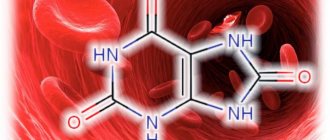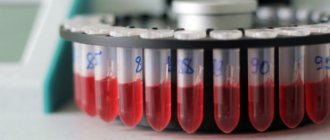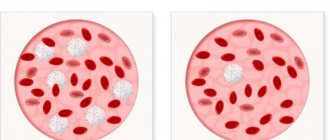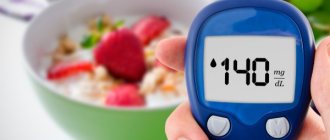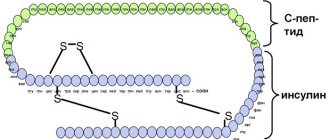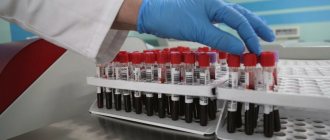Low blood sugar, called hypoglycemia, is considered a rather dangerous condition that requires immediate qualified medical attention. Most people believe that hypoglycemia is a condition that is unique to diabetes, but this is not true. Low blood sugar can be the result of both pathological and physiological factors.
Next we look at what low blood sugar means, how it manifests itself and how to deal with it.
A little about sugar and its functions in the body
Glucose is a material that provides the cells and tissues of the body with vital energy. It enters the body mainly with carbohydrates. After food is broken down in the stomach and upper parts of the small intestine, sugar enters the bloodstream.
In response to this, the pancreas releases the required amount of the hormone insulin, whose task is to distribute glucose and transport it throughout the body. Insulin is the “key” for sugar and facilitates its penetration into cells.
Features of the close “cooperation” of glucose and insulin in the body
Sugar performs a number of important functions:
- participation in metabolic processes;
- activation and support of the production of amino acids, fats, enzymatic substances, nucleic acids;
- support for the functioning of the heart and blood vessels;
- relief of hunger;
- normalization of the functioning of the nervous system, restoration of the body and its protection from stress;
- increased physical and mental activity;
- stimulation of the work of internal organs and systems.
Important! In a healthy person, sugar levels fluctuate throughout the day, but do not go beyond acceptable limits. A critical lack of blood sugar, especially if repeated repeatedly (before or after meals), may indicate a pathological condition that requires diagnosis and treatment.
What is dangerous about low levels of glucose in the body?
Hypoglycemia for a premature baby threatens the development of cerebral palsy, brain starvation, which threatens insufficient mental development.
A large percentage of newborn deaths from hypoglycemia due to starvation of the brain and nervous system.
Lack of glucose in a child’s body provokes a number of heart diseases and vascular pathologies. If not treated promptly, the child may enter a hypoglycemic coma.
About the numbers
In a healthy person, the blood glucose level is in the range of 3.33-5.55 mmol/l. If the readings drop below 3.3 mmol/l, we can talk about hypoglycemia, although this threshold is not always critical.
For each person, there are individual numbers at which we can talk about low sugar. One will feel great with a glycemia of 3 mmol/l, worse - with 2.7 mmol/l. For another person, already 3.2 mmol/l will be a critical indicator requiring immediate medical attention.
As a rule, it depends on the gender, age of the person, his constitution and body weight. This can also include lifestyle.
When should you see a doctor?
How to lower insulin in the blood?
The threshold for reducing glucose levels at which symptoms of hypoglycemia appear is individual for each patient. Some people may feel fine with a reading below 2.2 mmol/l, while for others a reading of 3 becomes critical and they are likely to develop coma.
Patients with type 1 diabetes should measure their blood sugar several times a day using a portable personal glucose meter. Those who do not use this device and are often unaware of the presence of diabetes (mostly adults who developed type 2 diabetes in adulthood) should be wary of the following and should be a reason for a visit to an endocrinologist:
- sudden increase in resting heart rate;
- feeling of fatigue and weakness in the lower extremities;
- increased sweating in the absence of physical activity;
- attacks of unreasonable fear, trembling in the hands;
- inability to concentrate;
- attacks of weakness or dizziness;
- visual impairment.
If one or several manifestations arise, a person’s first action should be to seek medical help and undergo all necessary tests. The doctor will consult the patient in detail, tell you what to do in such situations, and possibly recommend adjusting your lifestyle.
Causes of hypoglycemia
Low blood sugar occurs due to the following etiological factors:
- prolonged deliberate or forced refusal of food;
- the presence of insulinoma (pancreatic tumor that uncontrollably synthesizes insulin on its own);
- long-term use of medications or self-medication (insulin, glucose-lowering tablets, salicylates, beta-blockers);
- the effect of ethyl alcohol and its derivatives on the body;
- hepatitis;
- adrenal insufficiency;
- diabetes;
- neuropsychiatric disorders.
Uncontrolled use of medications is a step towards the development of hypoglycemia
If a person has diabetes, low glucose levels can be explained by an incorrectly selected dose of insulin, which is used in the treatment of almost all insulin-dependent and some non-insulin-dependent diabetics.
Another important point why there may be little sugar in the bloodstream in diabetes is large gaps between meals, alcohol consumption (delayed hypoglycemia) and significant physical activity.
There are provoking factors that help lower glycemic levels due to internal changes in the body. These include a long period of diabetes mellitus, pathology of the kidneys, liver and gastrointestinal tract, endocrine diseases (in particular, the thyroid gland).
Important! To this list you can add the period of pregnancy and lactation, alcoholism and hereditary predisposition.
You can read more about the causes of low blood sugar in this article.
Hypoglycemia: treatment
Below is an algorithm for helping with low blood sugar. It is intended for patients who are using a step-by-step treatment regimen for type 2 diabetes or a program for treating type 1 diabetes. It is assumed that you are on a strict low-carb diet and injecting low doses of insulin that correspond to it. And they have already stopped taking harmful pills for type 2 diabetes, which can cause hypoglycemia. Under these conditions, a strong overdose of insulin cannot, in principle, occur. To relieve hypoglycemia, there is no need to take carbohydrates in the amount of 1.5-2 bread units, as doctors usually recommend.
Dr. Bernstein says to treat low sugar, use only glucose tablets. In more severe cases, while the patient can still swallow, an aqueous solution of glucose. You need to take a low, precisely calculated dose of glucose, which will raise your sugar to 3.5-4.5 mmol/l, but not higher. To solve this problem, only glucose tablets and solution, which are sold in pharmacies, are suitable. No food products should be used because they act slowly and imprecisely. As a last resort - bread, crackers, pastries. A few grams will be enough! Do not give a diabetic sugar, flour products, honey, carbonated drinks, sandwiches, etc.
What dose of glucose is required to relieve hypoglycemia?
The required dose of glucose to relieve hypoglycemia depends on body weight. When a diabetic’s blood sugar drops sharply, it’s too late to run to the pharmacy for glucose tablets. Before you start treating diabetes with insulin, you need to stock up on this medication and keep it on hand. Glucose tablets are sold at any pharmacy and are inexpensive.
To calculate the dose, you need to know how much 1 gram of glucose raises blood sugar. It depends on the patient's body weight. Dr. Bernstein has accumulated the information he shared with us over many years of treating his own diabetes and working with patients.
Approximately how much does 1 g of glucose increase blood sugar?
| Body weight, kg | Effect of taking 1 g of glucose, mmol/l |
| 16 | 1,11 |
| 32 | 0,56 |
| 48 | 0,39 |
| 64 | 0,28 |
| 80 | 0,22 |
| 95 | 0,18 |
| 111 | 0,17 |
| 128 | 0,14 |
| 143 | 0,12 |
Let's look at an example of calculating the dose of glucose to relieve hypoglycemia. A glucometer showed that a diabetic who weighs 86 kg has a blood sugar of 2.6 mmol/l. The target level is 4.5 mmol/l. Difference: 4.5 mmol/l - 2.6 mmol/l = 1.9 mmol/l. The required body weight of 86 kg is not in the table. Let's take the adjacent values above and below and calculate the average: (0.22 mmol/l + 0.18 mmol/l)/2 = 0.2 mmol/l. So, we assume that 1 g of glucose in our patient will increase blood sugar by 0.2 mmol/l. Now you can calculate the required dose: 1.9 mmol/l / 0.2 mmol/l = 9.5 g. You should not take more glucose than the calculated amount. You can even round up to 9.0 g. Because if the sugar rises to 3.5-4.0 mmol/l, it will still be a good result.
Please note that in the example, the dose of glucose was calculated for a well-fed person with a body weight of 86 kg. For thin adults, and even more so for children, the required dose may be several times lower. It should not be exceeded. Re-measure your sugar with a glucometer after 15-30 minutes. Take more glucose if necessary. You should not use a handful of tablets at once to solve the problem in one fell swoop.
What are the treatment features for severe hypoglycemia?
In case of severe hypoglycemia, try to quickly treat the diabetic yourself, but you still cannot do without calling an emergency team. With moderately low blood sugar, the patient is able to eat glucose tablets or drink a liquid solution. Severe hypoglycemia is when there is serious impairment of consciousness. If a person has lost consciousness, he needs to be laid on his side and his mouth freed from any remaining food. It is forbidden to pour sweet liquids into the mouth, because this can cause a diabetic to choke and die. Call an ambulance! While she is driving, you can inject glucagon from a 1 ml syringe tube. Such ready-to-use syringe tubes are sold in pharmacies.
Glucagon is a hormone that causes the liver to release glucose from its stores into the blood. After its administration, the patient should regain consciousness within 5-10 minutes. If this does not happen, the glucagon injection can be repeated. This remedy is not effective for alcoholic hypoglycemia because intoxication causes the liver to lose its ability to release glucose into the blood. Also, glucagon will not help if there has already been severe hypoglycemia in the previous 24 hours. Because the glucose reserves in the liver were depleted by the previous attack and they have not yet had time to recover.
What medical care should be provided to the patient?
The emergency doctor should immediately administer 60 ml of 40% glucose solution intravenously, and then transport the patient to the hospital. During transportation and beyond, glucose is continuously administered through IVs until consciousness is restored. They check whether there was a traumatic brain injury or intracranial hemorrhage. They do a gastric lavage and give activated charcoal in case of an overdose of type 2 diabetes pills. In case of a severe overdose of insulin no later than 3 hours ago, surgical excision of the injection site is performed. If the patient's loss of consciousness continues for more than 4 hours, cerebral edema and subsequent unfavorable outcome are very likely.
For home treatment of low blood sugar, only glucagon in syringe tubes and glucose tablets are used from medications. Glucagon is expensive and has a limited shelf life. It is hardly advisable to buy it and keep it at home in reserve. Patients who are treated for diabetes using the methods described on this site greatly reduce their likelihood of severe hypoglycemia. It is unlikely that they will need glucagon. But it is recommended to purchase glucose tablets and keep them on hand. Diabetics who inject themselves with insulin may need to take this drug not only to treat hypoglycemia, but also to prevent low sugar. You cannot do without glucose tablets during long, hard sports training and physical work.
How much glucose do you need to inject during hypoglycemia to bring your blood sugar back to normal?
Glucose injections are required in severe cases if the diabetic has lost consciousness due to hypoglycemia. Correctly, the emergency doctor administers 60 ml of 40% glucose solution intravenously. Sometimes the hormone glucagon is also injected. After this, a dropper with a 10-15% glucose solution is placed. The patient is kept under a drip until he regains consciousness. He may be transported to the hospital in an unconscious state, while continuing to administer glucose drips.
A conscious diabetic can be given glucose tablets without resorting to injections. Patients who follow a low-carbohydrate diet inject insulin doses 2-7 times lower than standard. They practically never have a significant overdose. To raise sugar to the normal level of 4-5 mmol/l, 2-3 g of glucose tablets are enough for them. Bread, fruit, sweets, etc. should not be used.
Classification of hypoglycemia
A list of the most common forms of pathology in which the level of glucose in the blood of a child and an adult is below the permissible level:
- Severe – the pathology requires immediate medical correction (administration of carbohydrates, glucagon). This form can progress to a comatose state. In order to prevent the development of complications, it is important to raise the glycemic level to normal.
- Confirmed symptomatic - this form is characterized by laboratory confirmation, in which a blood test shows numbers of less than 3.3 mmol/l, and all obvious signs of hypoglycemia are present.
- Asymptomatic - as a rule, it is manifested only by laboratory indicators, there is no clinical picture of the pathology.
- Probable symptomatic - manifestations correspond to the specifics of the condition, but are not confirmed by diagnostic results.
- Relative - symptoms of low sugar are present, but according to the examination results, glycemia is within normal limits.
Determining the type of hypoglycemia is the prerogative of a qualified specialist
How to help with severe hypoglycemia?
The condition of acute sudden hypoglycemia must be stopped within 5–10 minutes, otherwise there is a risk of fainting and other life-threatening complications. To make up for the lack of glucose in the blood, you should eat or drink something sweet or containing carbohydrates.
The most effective products that help relieve an attack in 5–10 minutes are:
- fruit juice (half a glass is enough);
- sugar (1–2 teaspoons);
- honey (2 teaspoons);
- jam (1–2 tbsp);
- caramel (1–2 pcs.);
- lemonade or other sweet drink (1 glass).
After eating, the attack will be stopped, but you should not ignore the symptoms preceding it, even if it is still minor and does not cause much discomfort. It should be remembered that at any moment (if the dosage of blood sugar-lowering drugs is incorrect or a meal is skipped), the attack may recur, and it is not known what intensity it will be.
To patients. Any sign of hypoglycemia should be a reason to visit a doctor and undergo a thorough examination. If no pathologies are found, then it is necessary to use the doctor’s recommendations to reduce the likelihood of recurrence of alarming symptoms. If a disease is detected, get advice and therapeutic prescriptions that will stabilize the state of the endocrine system.
Symptoms
The pathology begins to manifest itself when blood sugar in women and men drops below 3 mmol/l. The following complaints appear:
- dizziness;
- cephalgia;
- impairment of consciousness and cognitive functions;
- pathological desire to eat;
- chills;
- twitching of fingers, limbs;
- nervousness, excitement;
- excessive sweating.
As hypoglycemia progresses, a person may fall into a coma. At the same time, body temperature decreases, breathing becomes noisy and can be heard from a distance. The pulse becomes frequent, barely audible, and low blood pressure is observed.
The tone of the eyeballs decreases, frequent urination is replaced by its complete absence. Seizures resembling epilepsy and convulsions appear. The patient loses consciousness. From this moment on, 4-8 hours remain to provide medical assistance. Next – cerebral edema, death.
Important! Symptoms of hypoglycemia may be similar to manifestations of other pathologies, so it is important that a doctor conduct a differential diagnosis.
Manifestations of moderate hypoglycemia
In order to always be on guard and be able to quickly respond to changes in the general well-being of yourself or a loved one, you should know the main signs that accompany low blood sugar. In an adult, the following manifestations are most often present:
- general weakness, causeless fatigue;
- headaches, dizziness;
- trembling (tremor) in the limbs, their numbness;
- tachycardia (rapid heartbeat);
- rapid, uneven pulse, drowsiness;
- excessive nervousness, irritability;
- feeling of extreme hunger, sweating;
- poor coordination of movements, pale facial skin,
- Pupils are dilated, there is double vision, darkening.
All of the above symptoms of low blood sugar can be observed both in a person sitting or lying motionless, or in a sleeping person. They are due to the fact that the brain consumes glucose in approximately the same quantities as the muscles, and if there is a lack of it, it also goes hungry.
Reference! Signs of nocturnal hypoglycemia develop due to a decrease in the functional activity of the endocrine system at a given time of day.
As a rule, a person has restless sleep, often accompanied by nightmares, he may behave noisily, and try to get up without waking up. As a result, the patient often falls out of bed, sweats profusely, wakes up with cramps in the lower extremities, and suffers from a headache in the morning.
If at this stage of hypoglycemia a person is not given glucose (best in a quickly digestible form: sugar, sweets, honey, cake, etc.), then his condition will worsen. A further drop in glucose concentration can cause more severe and life-threatening symptoms for the patient:
- confusion;
- incoherent speech;
- convulsive attacks.
A further decrease in glucose levels sometimes causes a stroke and/or coma, usually followed by death.
The most common signs of hypoglycemia
Low sugar in pregnant women and children
There are times when a pregnant woman’s condition requires her blood sugar to increase. This means that she had an attack of hypoglycemia. Such a pathological condition during the period of bearing a child is more the exception than the rule.
Why does hypoglycemia occur during pregnancy?
- changes in a woman’s hormonal background;
- active metabolic processes;
- strengthening the functioning of the endocrine apparatus;
- severe toxicosis accompanied by dehydration;
- hypovitaminosis;
- incorrect treatment of diabetes during pregnancy;
- high weight of a woman;
- multiple pregnancy.
Pregnancy is a period during which glycemic levels should be monitored frequently.
Women who have relatives with diabetes have a high risk of low glucose levels.
There is such a thing as neonatal hypoglycemia. It can be temporary, occurring in the first days of life. Disappears on its own or after minor drug intervention.
However, there is also a long-term form of pathology (persistent), which requires long-term treatment and is manifested by significant disturbances in carbohydrate metabolism. Such children need constant monitoring, as well as clarification of the presence of genetic abnormalities.
Content:
- General characteristics
- Reasons for the downgrade
- Symptoms of hypoglycemia
- Possible consequences
- First aid and further therapy
- Folk remedies
- Nutritional Features
← High blood sugar - how to treat and quickly lower it
Normalized blood glucose: symptoms of deviations →
A situation where there is low blood sugar is called hypoglycemia. This problem affects every person from time to time. When neglected, it poses a direct threat to life, as it affects brain function and energy metabolism.
What is hypoglycemia in a few lines
Complications and consequences
Mild hypoglycemia slightly affects a person’s quality of life. Weakness and nervousness appear, mood disappears, and increased fatigue occurs. Low sugar, which accompanies severe forms of pathology, is very dangerous due to its consequences and complications.
The consequences appear:
Blood sugar level in a healthy person
- attacks of psychosis;
- epilepsy;
- acquired dementia (dementia);
- blood clotting disorder;
- cerebrovascular accident;
- arrhythmia;
- heart attack;
- renal failure;
- glaucoma;
- cerebral edema;
- fatal.
Prevention of hypoglycemia
My glucometer is always with me, it will help.
Hypoglycemia is not as harmless as it might seem. A drop in blood glucose concentration reduces performance, impairs quality of life, and provokes the development of chronic diseases.
To prevent hypoglycemia, you must follow simple but effective rules:
- for diabetics it is important to follow the rules for taking insulin and its dosage;
- monitoring the concentration of glucose in the blood with a glucometer;
- In no case should you allow long breaks between meals;
- It is advisable to avoid alcohol consumption;
- when planning physical activity, it is necessary to provide for mandatory additional nutrition in the form of chocolate, sweets, and sugar-containing products;
- be sure to drink warm tea with sugar or honey after intense physical activity;
- You should always have d-glucose or glucagon tablets with you.
A low concentration of glucose in the blood, if it is constant or frequent, indicates insufficient energy metabolism in the body. It is commonly believed that only diabetics should measure their blood sugar levels, but this is not true. The advent of portable glucometers allows anyone to monitor this indicator.
A modern person who follows the rules of a healthy lifestyle is obliged to monitor his energy, for which he must have a glucometer at home or always with him. Controlling glucose levels is important for the prevention of many metabolic pathologies. Glucose is not sugar, it is life itself.
How to check your blood sugar level?
Glycemic levels are monitored in several ways. The most common is a blood test, which is taken in a public or private laboratory. What sugar level is known the next day, in emergency cases - within 10-15 minutes. The study is carried out on an empty stomach or immediately at the time of an attack.
The second method is to measure your sugar level with a glucometer. This method is carried out both at home and in a hospital or outpatient clinic. Glycemia is measured with a special portable device, which includes a lancet (which is used to make a puncture to draw blood) and test strips (treated with chemical reagents for the necessary reaction with blood components).
Important! Within a minute, the diagnostic result is displayed on the screen. It is important to have such a device for patients with diabetes and those people who often experience similar conditions of critical low blood sugar.
A laboratory doctor will help you clarify your sugar level in the laboratory.
More about blood glucose
Initially, it is worth saying that a blood test for sugar is a generally accepted expression, but within the framework of modern medicine it is not entirely correct. The very phrase “blood sugar” dates back to the Middle Ages. Doctors and healers of that time believed that the amount of sugar was directly related to the appearance of excessive thirst, pustular infections and frequent urination.
Today, it is no secret to doctors that there is no so-called sugar (sucrose) in the blood, because studies have confirmed that simple sugars are converted into glucose through chemical reactions. And it, in turn, performs one of the leading functions in metabolism. And now, when we talk about the normal blood sugar level, we mean the content of glucose, a universal substance that supplies energy to all human tissues and organs.
With its participation, heat exchange occurs, the brain and the entire nervous system are nourished, and toxic substances are removed from the body. When supplied with food, glucose is consumed by tissues, and is also deposited and accumulated in muscles and liver in the form of glycogen, which, if necessary, can again be converted into simple sugars and returned to the blood.
Thus, the circulation of glucose in the body supports its normal functioning, and, consequently, the person’s well-being. Glucose (C6H12O6) is one of the most important substances in terms of metabolism, and any disturbance in its concentration can cause the development of severe complications.
In addition to glucose, when sucrose is broken down in the gastrointestinal tract (gastrointestinal tract), fructose is also formed, which is also a simple saccharide, like the first. In diabetes mellitus, there is a deficiency of hormones that promote the absorption of glucose, as a result of which it is retained in the blood instead of being converted into glycogen.
Increased glucose in the blood, as well as in the urine, are direct laboratory signs of the disease and pose a danger to human life and health. Insulin, which is prescribed to such patients, helps transform free glucose into glycogen.
At the same time, it often happens that an incorrectly selected dosage of insulin or a meal taken at the wrong time leads to a lack of glucose and the development of hypoglycemia, which is the same dangerous condition as hyperglycemia. In certain situations, serious health consequences can develop even with short-term glycemia, especially if the level drops very quickly.
How to increase your sugar levels
Treatment of hypoglycemia begins with nutritional correction. A prerequisite that helps prevent the development of attacks is diet. Its principles are as follows:
- Frequent meals, portions should be small, breaks between the intake of food into the body no more than 3 hours.
- Avoid coffee or reduce its consumption, since this drink is considered a stimulator of insulin synthesis.
- Quit alcoholic beverages and smoking.
- The diet should include up to 150 g of carbohydrates daily (unless hypoglycemia occurs due to diabetes mellitus).
- Include nuts, lean fish and meats, vegetables, and fruits in your individual menu.
- With your doctor's permission, use supplements rich in vitamins and microelements. They will reduce the risk of complications and support the functioning of internal organs.
General characteristics
Every day, every person replenishes energy reserves with food, along with which glucose enters the body. Its optimal level is considered to be 3.5-5.5 mmol/l. If sugar is below normal, what does this mean? The body experiences an energy deficiency and hypoglycemia develops. Chronically low blood sugar can have serious consequences.
Reasons for the downgrade
Jumps in glucose levels can be triggered by both more serious illnesses and little things in everyday life. Rare isolated cases are considered acceptable, but if there is persistently low blood sugar, the causes must be sought and eliminated immediately.
Low blood sugar, causes:
- Physical work . After playing sports or other prolonged physical activity, energy reserves, which are represented by glucose, are depleted.
- Nutrition . Irregular meals, long-term diets, in particular low-carbohydrate diets, and an unbalanced diet are all good prerequisites for creating a glucose deficiency.
- Response hypoglycemia . This is the body’s response to a sharp increase in sugar, for example, after a large portion of sweets.
- Alcohol and smoking . They initially cause an increase in indicators, and then their rapid decline.
- Overdose of medications . Most often, hormonal medications are to blame.
- Diseases . Existing diabetes, thyroid dysfunction, problems with the pancreas, gastrointestinal tract, liver, kidney failure.
Reasons for low glucose levels
Important: hypoglycemia response is associated with increased insulin production after consuming large amounts of sugar. As a result, glucose is completely processed and this explains why its level drops 1-2 hours after eating.
We also recommend studying this topic:
Fluctuations in blood glucose levels during pregnancy
Symptoms of hypoglycemia
It is quite easy to suspect hypoglycemia, since its symptoms are familiar to everyone. After physical activity or during prolonged fasting, everyone has experienced its manifestations. Symptoms in women and men are expressed almost identically:
- Weakness. A lack of energy leads to rapid fatigue, lack of sleep, and a broken state.
- Hypotension. Low sugar, low blood pressure - everything is interconnected.
- Headache. Brain cells do not receive enough nutrition, pain and nausea occur.
- Sweating. This is especially noticeable at night.
- Body trembling. There is a slight tremor of the limbs and chills.
- Nervous disorders. Expressed in irritability, anxiety, depression.
- Deterioration of vision. A sharp deterioration in vision, blurred images before the eyes, spots.
- Feelings of hunger and thirst. Constantly want to eat and drink, even if your stomach is full. I am especially drawn to sweets and baked goods.
Symptom of hypoglycemia
If you notice signs of a problem, you should go to the hospital for control tests and more detailed monitoring of your health. If you do not start hypoglycemia, you can get rid of it on your own. Otherwise, lifelong treatment may be needed.
Blood sugar levels are very important during pregnancy. A table with standards is available on our website.
Possible consequences
Let's take a closer look at why glucose deficiency is dangerous. First of all, it leads to weakening of the body and all its systems. The lack of the main source of energy does not allow cells to perform their functions fully. As a result, proteins and fats are broken down, which clogs the body with their breakdown products. In addition, the nutrition of the brain and the functioning of the main centers of the nervous system are disrupted.
Important! A particularly undesirable situation is when the glucose level after a meal is lower than on an empty stomach. Responsive hypoglycemia is a precursor to diabetes mellitus. Diabetes is one of the most serious consequences of sugar deficiency.
Pathogenesis of hypoglycemia
It is very important to know how to increase glucose when it is significantly reduced, otherwise the most severe consequences may develop - hypoglycemic coma with the possibility of death.
Help with an attack of hypoglycemia
In the initial stages, you should give the patient something sweet. This could be refined sugar, candy, cookies, sweet hot tea. Against the background of a precomatous state, the patient should be placed on his side (so as not to choke on vomit if there is any), and dentures should be taken out.
In the absence of consciousness, 1 ml of glucagon is injected under the skin or into a vein. Further assistance is provided in a hospital setting.
Ambulance team - specialists who will arrive to the patient in case of an attack of hypoglycemia
Diagnosis of hypoglycemia
In order for a doctor to diagnose hypoglycemia and determine the reasons for its decrease, it is enough to take a blood sugar test. Blood for testing is taken from a finger.
The doctor must determine why this is happening. The doctor also examines the patient’s body and checks his emotional and psychological state.
It is important to find out the patient’s lifestyle, fluctuations or increase in body volume, as well as what medications the patient is taking for this period.
The reasons for sugar fluctuations may be precisely this.
Phases of development of a pathological condition
When a sharp decrease in the amount of sugar in a woman’s body occurs, the development of hypoglycemic syndrome is observed, in which the symptoms of hypoglycemia increase much faster than in the case of a normal decrease in the amount of sugar in the blood plasma.
New information: How to quickly lower blood sugar at home?
Conventionally, the course of hypoglycemic syndrome can be divided into four phases.
In the first phase, symptoms such as a pronounced feeling of hunger, increased drowsiness, hypotension, frequent mood swings from a tearful state to a cheerful state are observed; during this period of development of the pathology, the sick woman experiences increased irritability.
The second phase of the progression of hypoglycemic syndrome is characterized by the addition of tachycardia, increased force of heart contractions, visual impairment, and the appearance of muscle tremors throughout the body to the symptoms of the first phase. During this phase, a woman develops a feeling of fear of death.
For the third phase of the syndrome, the appearance of a state of euphoria reminiscent of alcohol intoxication is typical; in addition, during this period, excitation of the nervous system is observed, uncontrollability in behavior is recorded and the feeling of fear of death disappears, and inadequacy in behavior is additionally revealed.
The fourth and final phase in the progression of hypoglycemic syndrome is characterized by trembling throughout the body, which may be followed by seizures, loss of vision, fainting and the development of a coma.
The initial stages of the syndrome are usually not dangerous for the woman’s body and for the brain, this is due to the fact that after them there are no irreversible consequences. The last stages without timely assistance lead to death.
Symptoms of hypoglycemia
The main symptoms of hypoglycemia include:
- Adrenergic disorders - mydriasis, severe sweating, pale skin, tremor, muscle hypertonicity, agitation along with restlessness, anxiety and aggression, tachycardia and increased blood pressure.
- Parasympathetic symptoms - general weakness of the body, nausea with vomiting, an unclear feeling of hunger.
- Neuroglycopenic manifestations - dizziness and moderate headache pain, disorders of central origin and breathing, disorientation and fainting, disturbances of consciousness with amnesia, focal and systemic neurological symptoms, manifestations of primitive automatisms, sometimes inappropriate behavior. Less commonly, paresthesia and diplopia are observed.
Proper nutrition and diet
If your blood sugar level is low, your endocrinologist will prescribe an individual diet for you, taking into account the severity of the problem, the presence of a certain type of diabetes mellitus, and the current state of your body.
General principles:
- Increase your intake of complex carbohydrates by eating vegetables, durum wheat pasta, and whole grain bread.
- Completely exclude alcohol, semolina, soft wheat pasta, baked goods, fatty and very strong broths, all types of cooking and meat fats, spices, smoked meats, pepper and mustard from your diet.
- Consume sweets, cookies, honey and juice very moderately.
- Eat in small portions, remember to eat protein foods with a minimum of fat.
- Focus on products with maximum fiber, which slows down the absorption of sugar extracted by the body from complex carbohydrates. The best options are corn, peas, and jacket potatoes.
- Be sure to include fruits in your menu, both fresh and dried or in their own juice, containing moderate or low amounts of sugar.
- Choose lean sources of protein - fish, beans, chicken or rabbit meat.
- Limit the consumption of caffeine as much as possible, which in large quantities significantly aggravates the development of hypoglycemia.
- Replace carbonated drinks with non-carbonated mineral drinks.
- You can also get the protein your body needs from alternative foods - nuts, low-fat dairy products.
Approximate daily menu
- We have breakfast with two boiled eggs and unsweetened tea with a small piece of whole grain bread.
- Have a snack with a glass of milk or one medium-sized unsweetened fruit.
- We have lunch with soup with low-fat meat broth and vegetable salad. Additionally - a portion of steamed fish and tea.
- We have an afternoon snack with some fruit and herbal tea. An alternative is 50 grams of walnuts.
- We have dinner with stewed chicken or rabbit meat with a vegetable side dish. You can use chicory as a substitute for tea and coffee.
- Two hours before bedtime - a glass of 1 percent kefir.
Watch your diet, eat right, follow a daily routine, and in most cases you can get rid of hypoglycemia without medications!
Diet to prevent low sugar
Proper nutrition during the day will ensure a uniform intake and expenditure of energy, negating the onset of hypoglycemia attacks. The table provides a list of products and dishes that will create the necessary nutritional comfort.
| Breakfast | Dinner | Snack | Dinner |
| 2 hard-boiled eggs; A couple of slices of grain bread; Herb tea; A cup of milk or kefir (in an hour). | Lean meat, steamed or grilled fish – 100-150 grams; Green vegetable salad; Fruit juice without added sugar. | Fruits (apple, kiwi, grapefruit) | Vegetables – baked or stewed + a piece of meat, lean fish. |
During the day, it is recommended to drink 1.5-2 liters of clean water; you can partially replace water with herbal tea.
When the diet does not help achieve the desired result, glucose preparations (Acarbose, Glucagon and others) are used. In severe situations, glucose is administered intravenously. If hypoglycemia is caused by a benign neoplasm, surgery to remove the tumor is recommended.
Treatment
If the sugar concentration is low, it is necessary to identify the reasons that could provoke this condition. Anamnesis is collected by interviewing the patient himself or his relatives, if the patient himself is in serious condition.
In the event that low sugar levels are caused by dysfunction of the endocrine glands (pancreas, pituitary gland, adrenal glands), treatment aimed at normalizing hormonal levels is necessary. If the cause of the disease is an incorrectly selected dose of insulin, it is necessary to adjust it.
People with diabetes need to use a glucometer to monitor their glucose levels. Under no circumstances should you take or adjust the dosage of sugar-lowering medications on your own.
In addition, you need to watch your diet. People with low glucose concentrations need carbohydrates, but not sugar and sweets, but cereals, vegetables, pasta, and bread. In case of a sharp decrease in glucose, patients should carry a piece of sugar, a chocolate bar or candy with them. Patients should give up alcohol, or at least significantly reduce their consumption.
If there is a sharp deterioration in health caused by hypoglycemia, it is necessary to call an ambulance. After clarifying the diagnosis, the doctor will give an intravenous injection of glucose. In case of loss of consciousness, it is necessary to administer adrenaline (subcutaneously) and glucagon (intramuscular).
Everyone knows about the analysis for measuring glucose levels. It is necessary to regularly monitor the sugar concentration, since any deviations from the normal level are very dangerous. When sugar levels drop, hypoglycemia develops - a serious disease that can be fatal.
